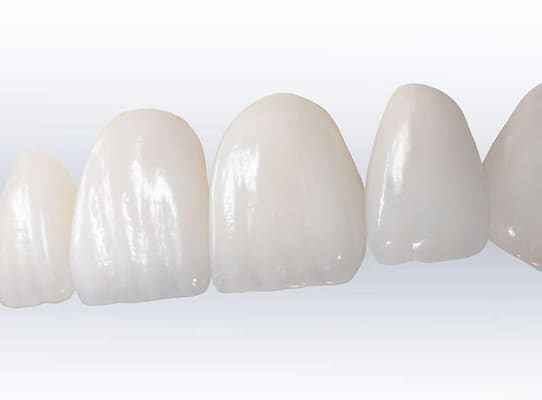Feldspathic Veneers

Creating feldspathic porcelain veneers is a master craft method that few dentist/technician teams use. This method employs a laborious hand stacking technique. The ceramist applies small amounts of different porcelains mixing into a single monolithic layer.
These porcelains vary in levels of opacity, brightness, and color, and are artfully laid down as the tooth form is built up. Feldspathic porcelain veneers require less drilling on the teeth because it matches better.
This type of veneer is desired due to unmatched blending capabilities as well as aesthetics.
Why are feldspathic veneers so successful …again!


- As patients have begun requesting less invasive treatments and higher levels of esthetics, the use of feldspathic veneers is resurging.
- With this comes the desire for thinner veneers and preservation of natural tooth structure.
- Modern feldspathic veneers allow ceramists to create thicknesses of less than 0.5 mm, which can be fabricated to a minimum thickness of 0.3 mm.
- Through the use of advanced bonding agents, the capacity to predictably bond veneers to enamel is great as well.
- Today, many ceramists are not being trained in the art of sculpting powder/liquid porcelains to form the highly esthetic feldspathic veneers, especially thin veneers.
- This creates a problem because the esthetic value exhibited in these restorations depends on the ceramist’s ability to build depth of color and translucency into the restoration.8 Dentists and their ceramists must also know when it is appropriate to use this slightly weaker restorative material in order to prevent post treatment fracture issues.
- Patients today demand much more from their dentists and laboratory ceramists.
- As a result, highly esthetic restorations and minimal-to-no-preparation restorations are no longer mutually exclusive.
- Therefore, dental professionals must consistently find a way to select treatment options that focus on the patient’s best interest. With this in mind, a recent resurgence in the use of conventional feldspathic porcelain veneers has developed.
- These conventional dental restorations are generally indicated for anterior teeth and occasional bicuspid use; rare molar placement would be acceptable only when all risk parameters are at the least risk level.
- In addition, feldspathic porcelain veneers are ideal when significant enamel remains on the tooth and generally when there is low flexure and stress risk assessment. Finally, these restorations absolutely require long-term bond maintenance for success.
With increased patient demands for enhanced esthetics and a need for restorative materials that closely mimic the patient’s natural dentition, feldspathic porcelain represents the premier esthetic material for custom restorations that are conservative and predictable for appropriate indications.
Based on its high esthetic value and little-to-no preparation requirements, feldspathic porcelain enables dentists and their ceramists to provide esthetic treatments that are much less invasive, which is precisely what patients expect.
As patient demands for better esthetics have increased in recent years, so too has the need for restorative materials that closely mimic the patient’s natural dentition. Initially used for the creation of porcelain dentures, feldspathic porcelain has emerged as the premier esthetic material for custom veneer restorations. In recent years, the use of hand-layered powder/liquid feldspathic porcelain has been revived based on its highly esthetic values and little-to-no preparation requirements. By keeping preparation to a minimum, less tooth structure is lost and procedures are much less invasive, which is exactly what patients desire.
Feldspathic porcelain is considered one of the most appealing cosmetic solutions. This veneering fabrication style may be recommended for patients when:
- The drilled tooth still has most of its enamel
- The patient does not grind their teeth
- When shade matching is difficult
- With extremely demanding patients
Like with most types of dental veneers, it is important to make certain considerations before making the commitment. Feldspathic veneers should be avoided if:
- The patient regularly grinds their teeth – because the veneers are so thinly structured, continuous grinding could cause the veneers to chip or fracture.
- The teeth have minimal or no enamel left – this type of veneer bonds with enamel, so if the patient’s tooth enamel has worn away, then this type of veneer may not be the most suitable option.
- You are a lover of hard or sticky foods – this could cause damage to the veneers, meaning early replacement would be needed
It depends on your dentist and how much tooth is left when the drilling stops. They are very strong when your dentist is conservative with the drill and leaves the majority of enamel in place. Feldspathic porcelain bonds extremely well to enamel. The tooth is actually strengthened by the presence of the new veneer.
The feldspathic restoration is considered monolithic with one type of porcelain. It does not have a strong coping substructure to support it. The tensile strength of 85 MPa is low on its own and needs to be treated like fine china until bonded onto the tooth. This type of restoration gains its strength from the bond to enamel. If supported and bonded to enamel, it is incredibly strong.
Most dentists drill too much tooth structure away for this type of veneer. Often less than 50% of the remaining exposed clinical crown has enamel to bond to. If this is the case, then the feldspathic porcelain restoration will be one of the weakest options.
It would be contraindicated for patients who are tough on their natural teeth. Understandably, the choice of restorative material is often made intra-operatively. When more than 50% of the enamel has been removed during the drilling process, a crown might be a better option. Crowns don’t require as much enamel for bonding.
Your cosmetic dental specialist will take a series of steps to cement your veneers:
- Your teeth are acid etched with a blue gel. This helps improve the bond strength between your teeth and the feldspathic veneers.
- The area is isolated to keep the site entirely dry.
- Cement and bonding agents bond the veneers onto your teeth.
- The excess cement is removed, and the adhesive is solidified permanently using a dental light.



